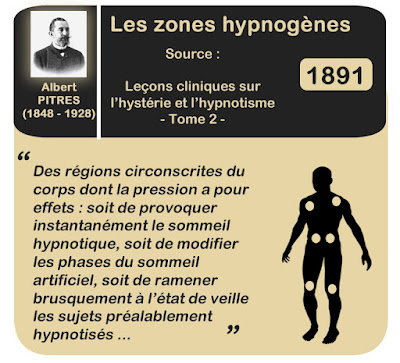Rapport et Autohypnose
J'ai eu des sujets qui voulaient apprendre l'autohypnose. J'ai rapidement découvert que s'ils entraient en transe en pensant: "Eh bien, voyons, le Dr Erickson m'a appris à entrer en transe", alors je pourrais entrer dans le bureau [où ils se trouvaient en "autohypnose"] et être en rapport avec eux. Mais quand ils étaient vraiment en autohypnose, je n’vais pas de rapport avec eux et personne d’autre n’avait de rapport avec eux. Pas même le téléphone. Rien n'avait de rapport. Ils [les sujets eux-mêmes] l'avaient! ...
L'autohypnose ne s'appuie pas sur un enseignant. Quand des sujets se servent de moi, ou qu'ils se rappellent de ce que je leur ai appris, je suis en rapport avec eux. Je me souviens d'un patient en psychiatrie lors d'un séminaire en hypnose qui est entré spontanément dans une transe profonde. Il n'y a eu aucun effort de ma part pour la démonstration. Je ne faisais que raconter l'histoire et les phénomènes de l'hypnose et j'ai remarqué qu'elle était en transe profonde. Ainsi, à la fin du séminaire, j'ai créé une perturbation en essayant de comprendre des choses au tableau. Elle s'est réveillée de cette transe sans savoir qu'elle y avait été.
Par la suite, elle m'a dit qu'elle était intéressée par l'autohypnose. Je lui ai demandé si elle voulait d'abord apprendre à être hypnotisée ou si elle voulait l'expérimenter elle-même. Elle m'a dit qu'elle pensait qu'elle préférerait expérimenter d'abord [seule]. Eh bien, j'ai surveillé son bureau de près. Un samedi après-midi, elle a expérimenté [seule]. Elle a installé un certain nombre d'objets à regarder .., je n'étais pas en rapport avec elle. Mais elle entra dans une très bonne transe. Puis plus tard, je lui demandai si elle aimerait être hypnotisée. Elle accepta. Alors je la mis en transe. Lorsque je l’interrogeai sur la transe en autohypnose, sa réaction fut : "C’est personnel! Mais je vais vous en parler si vous voulez vraiment savoir." Mais c'était à elle! C'est vrai, ça l'était! En d'autres termes, je n'ai pas eu accès à cette expérience particulière.
Elle me demanda plus tard de lui apprendre la "self-hypnose" (qui est la même chose que l'autohypnose). J'ai très soigneusement évité la mise en place de l'hypnose en utilisant les trombones qu'elle avait sur son bureau [qu'elle avait apparemment regardé pour tomber dans l'auto-hypnose]. Je lui ai demandé de regarder un calendrier pour l'auto-hypnose. Puis, plus tard, lorsque j'entrai dans son bureau alors qu'elle utilisait le calendrier pour s'autohypnotiser, je fus en rapport avec elle. Mais quand elle utilisa les trombones, je ne fus plus en rapport avec elle. Plus tard, je lui demandai d'utiliser les trombones et j'étais en relation avec elle!
Par conséquent, l'hypnothérapeute n'est pas en rapport avec des sujets qui utilisent leurs propres méthodes pour s'autohypnoser. Si, toutefois, les sujets suivent les directives de l'hypnothérapeute ou utilisent des ponts associatifs puissants avec le thérapeute, alors ils seront en rapport l'un avec l'autre pendant l'auto-hypnose.
-------Texte original ------------
I've had subjects who wanted to learn autohypnosis. I promptly found out that if they went into a trance thinking, "Well, let's see, Dr. Erickson taught me how to go into a trance, " then I could walk into the office [where they were going into "autohypnosis"] and be in rapport with them. But when they really went into autohypnosis, I didn 't have rapport with them and nobody else had rapport with them. Not even the telephone. Nothing had rapport. They [the subjects themselves] had it! ...
Autohypnosis does not use a teacher. When subjects start using me, or any recollection that I taught them such-and-such, then I am in rapport with them.. I remember a resident in psychiatry at a seminar in hypnosis who went into a deep trance spontaneously. There was no effort on my part to demonstrate. I was just giving the history and phenomena of hypnosis, and I noticed she was in a deep trance. So at the close of the seminar I created a disturbance trying to figure things at the blackboard. She awakened from that trance without knowing she'd been in one. Subsequently she told me she was interested in autohypnosis. I asked her if she wanted to learn to be hypnotized first, or did she want to experiment herself. She told me she thought she would prefer to experiment first [on her own]. Well, I kept a close watch on her office. One Saturday afternoon she experimented [on her own] . She set up a number of objects to look at.. , I wasn't in rapport with her. But she went into a very good trance. Then later I asked her if she would like the experience of being hypnotized. She agreed. So I put her in a trance. Her reaction when I questioned her about the autohypnotic trance was: "That's mine! But I'll tell you about it if you really want to know." But that was hers! That's right, it was! In other words I did not have access to that experience except . She asked me later to teach her self- through her permission.. hypnosis (which is the same as autohypnosis). I very carefully avoided the set up of paperclips she had on her desk [which she apparently had stared at to go into self-hypnosis]. I had her look at a calendar to go into self-hypnosis. Then later when I walked into heroffice while she was using the calendar for self-hypnosis, I was in rapport with her. But when she used the paper clips, I was out of rapport with her. I later asked her to use the paper clips and then I was in rapport with her! [Therefore, the hypnotherapist is not in rapport with subjects who use their own methods of going into self-hypnosis. If, however, subjects are following the hypnotherapist's directives, or are using any strong associative bridges to the therapist. then they will be in rapport with each other during the self-hypnosis.]






